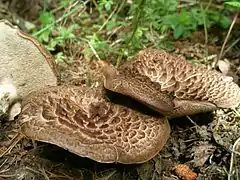Sarcodon
Sarcodon is a genus of fungi in the family Bankeraceae, which is part of the order Thelephorales known for its almost universal ectomycorrhizal life style.[1] The genus owes its name to the presence of teeth-like spines on the hymenophore, it is derived from ancient Greek; sarco = flesh and odon = tooth. This is why they are commonly called "tooth fungi", or "Hydnoid fungi".
| Sarcodon | |
|---|---|
 | |
| Sarcodon imbricatus | |
| Scientific classification | |
| Kingdom: | |
| Division: | |
| Class: | |
| Order: | |
| Family: | |
| Genus: | Sarcodon |
| Type species | |
| Sarcodon imbricatus (L.) P.Karst. (1881) | |
| Species | |
|
See text | |
Several species of the Sarcodon genus, including Sarcodon imbricatus (see figure), are edible. The fungus can be bitter, but that is less apparent in younger specimens. In China, it is a popular edible mushroom and it is used for lowering of cholesterol level, muscles relaxation and blood circulation.[2]
Traits
Species of the Sarcodon genus have yellow to brown tinted basidiospores,[3] with lengths in the range of 7.4-9 µm.[4] The basidiomata is often soft and fleshy.[3]
Species
As of September 2015, Index Fungorum listed 49 valid species of Sarcodon.[5] However, in 2019 Larsson et al. transferred 12 species into the genus Hydnellum.[4]
- Sarcodon aglaosoma
- Sarcodon atroviridis
- Sarcodon bubalinus
- Sarcodon caliginosus
- Sarcodon calvatus
- Sarcodon carbonarius
- Sarcodon catalaunicus
- Sarcodon conchyliatus
- Sarcodon cyanellus
- Sarcodon cyrneus
- Sarcodon dissimulans
- Sarcodon excentricus
- Sarcodon harrisonii
- Sarcodon humilis
- Sarcodon ianthinus
- Sarcodon illudens
- Sarcodon imbricatus
- Sarcodon lanuginosus
- Sarcodon leucopus
- Sarcodon pakaraimensis[6]
- Sarcodon portoricensis[6]
- Sarcodon praestans
- Sarcodon procerus
- Sarcodon quercophilus[6]
- Sarcodon quietus
- Sarcodon regalis
- Sarcodon rimosus
- Sarcodon roseolus
- Sarcodon rutilus
- Sarcodon scabripes
- Sarcodon squamosus
- Sarcodon stereosarcinon
- Sarcodon subfelleus
- Sarcodon thwaitesii
- Sarcodon umbilicatus[6]
- Sarcodon ussuriensis
- Sarcodon ustalis
- Sarcodon wrightii
References
| Wikimedia Commons has media related to Sarcodon. |
- Tedersoo, L.; May, TW.; Smith, ME. (2010). "Ectomycorrhizal lifestyle in fungi: global diversity, distribution, and evolution of phylogenetic lineages". Mycorrhiza. 20 (4): 217–263. doi:10.1007/s00572-009-0274-x. PMID 20191371.
- Jang NS. "Method for manufacturing health beverage from 'Sarcodon aspratus'". Retrieved 29 March 2020.
- Geesteranus, Maas RA (1975). Die Terrestrischen Stachelpilze Europas (The Terrestrial Hydnums of Europe). 1. North-Holland Publishing. pp. 1–127.
- Larsson; Svantesson; Miscevic; Kõljalg; Larsson (2019). "Reassessment of the generic limits for Hydnellum and Sarcodon (Thelephorales, Basidiomycota)". MycoKeys. 54: 31–47. doi:10.3897/mycokeys.54.35386. PMC 6579789. PMID 31231164.
- Kirk PM. "Species Fungorum (version 26th August 2015). In: Species 2000 & ITIS Catalogue of Life". Retrieved 9 September 2015.
- Grupe, Arthur C.; Baker, Anthony D.; Uehling, Jessie K.; Smith, Matthew E.; Baroni, Timothy J.; Lodge, D. Jean; Henkel, Terry W. (2015). "Sarcodon in the Neotropics I: new species from Guyana, Puerto Rico and Belize". Mycologia. 107 (3): 591–606. doi:10.3852/14-185. PMID 25661714.